劳动经济学第四章
- 格式:pptx
- 大小:383.99 KB
- 文档页数:32
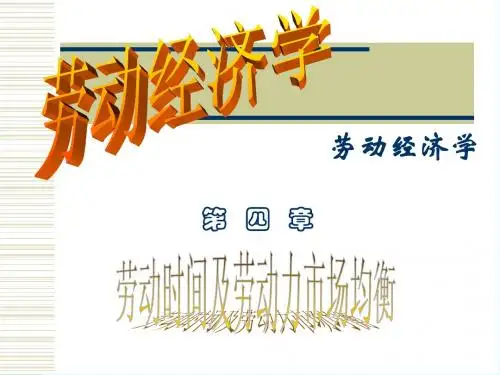
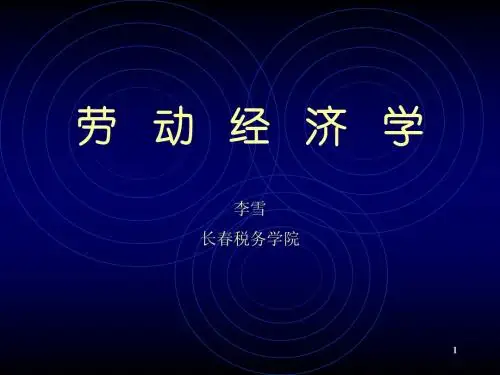
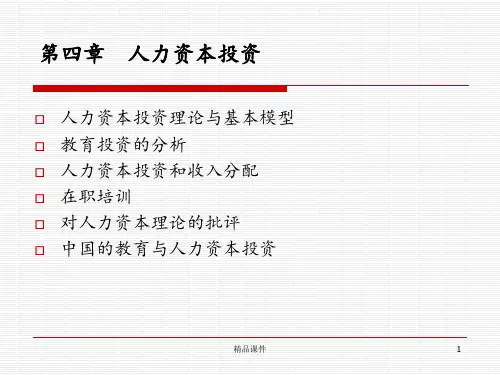
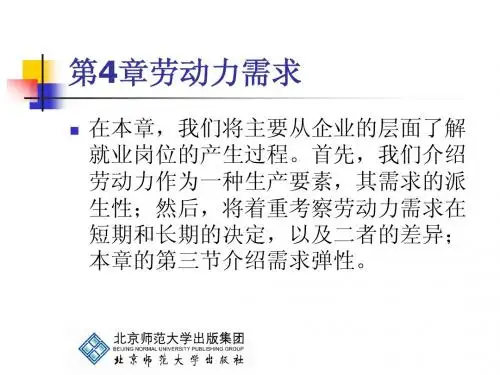

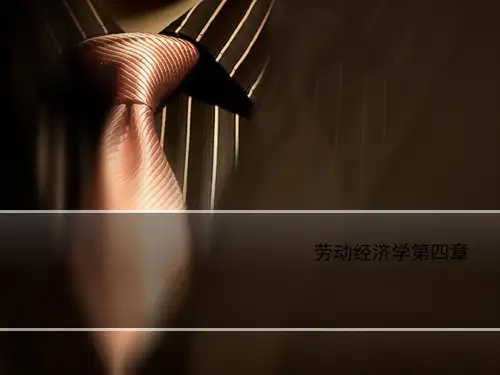
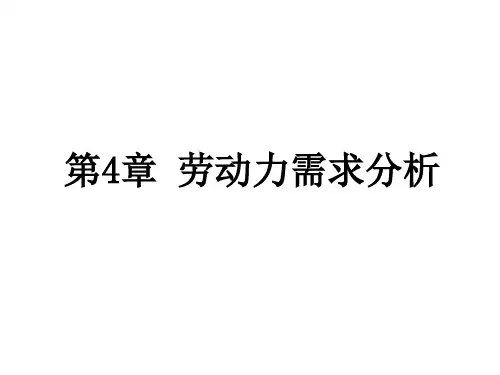
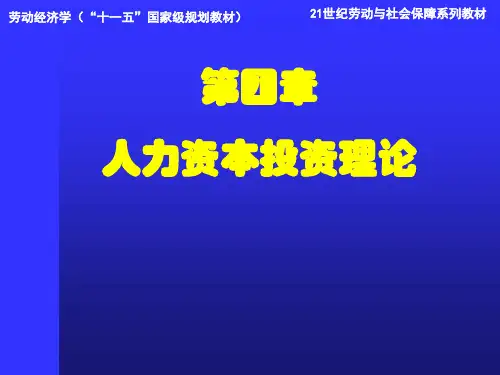
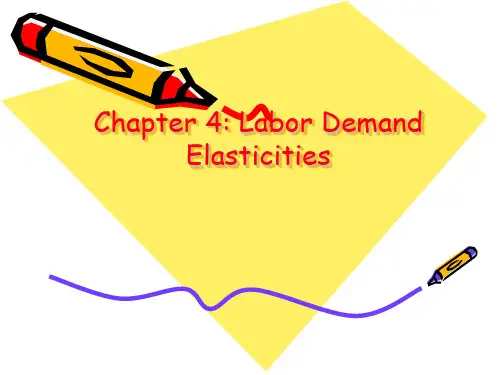
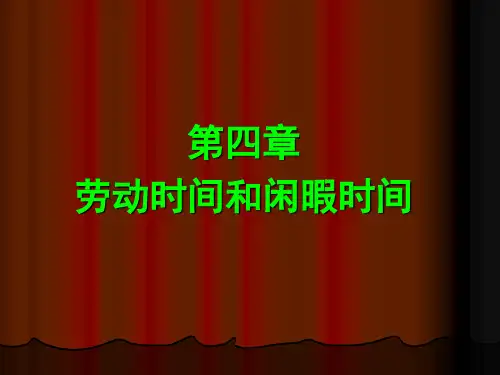
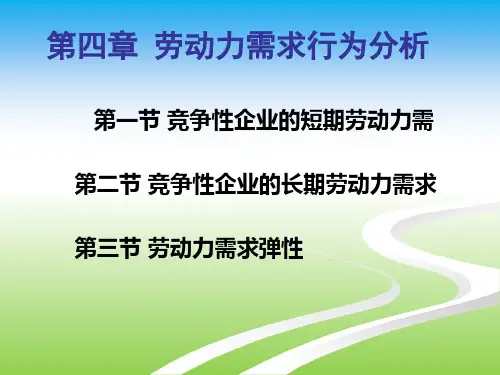
CHAPTER 44-1. Suppose there are two inputs in the production function, labor and capital, and these two inputs are perfect substitutes. The existing technology permits 1 machine to do the work of 3 persons. The firm wants to produce 100 units of output. Suppose the price of capital is $750 per machine per week. What combination of inputs will the firm use if the weekly salary of each worker is $300? What combination of inputs will the firm use if the weekly salary of each worker is $225? What is the elasticity of labor demand as the wage falls from $300 to $225?Because labor and capital are perfect substitutes, the isoquants (in bold) are linear and the firm will use only labor or only capital, depending on which is cheaper in producing 100 units of output.The (absolute value of the) slope of the isoquant (MP E / MP K ) is 1/3 because 1 machine does the work of 3 men. When the wage is $900 (left panel), the slope of the isocost is 300/750. The isocost curve,therefore, is steeper than the isoquant, and the firm only hires capital (at point A ). When the weekly wage is $225 (right panel), the isoquant is steeper than the isocost and the firm hires only labor (at point B ).Weekly Salary = $300 Weekly Salary = $225The elasticity of labor demand is defined as the percentage change in labor divided by the percentage change in the wage. Because the demand for labor goes from 0 to a positive quantity when the wagedropped to $225, the (absolute value of the) elasticity of labor demand is infinity.LaborCapitalLaborCapital4-2. (a) What happens to the long-run demand curve for labor if the demand for the firm’s output increases?The labor demand curve is given by VMP E = MR x MP E. As demand for the firm’s output increases, its marginal revenue also increases. Thus, an increase in demand for the firm’s output shifts the labor demand curve to the right.(b) What happens to the long-run demand curve for labor if the price of capital increases?To determine how an increase in the price of capital changes the demand for labor, suppose initially that the firm is producing 200 units of output at point P in the figure. The increase in the price of capital (assuming capital is a normal input) increases the marginal costs of the firm and will reduce the profit-maximizing level of output to say 100 units. The increase in the price of capital also flattens the isocost curve, moving the firm to point R. The move from point P to point R can be decomposed into a substitution effect (P to Q) which reduces the demand for capital, but increases the demand for labor, and a scale effect (Q to R) which reduces the demand for both labor and capital. The direction of the shift in the demand curve for labor, therefore, will depend on which effect is stronger: the scale effect or the substitution effect.4-3. Union A wants to represent workers in a firm that hires 20,000 person workers when the wage rate is $4 and hires 10,000 workers when the wage rate is $5. Union B wants to represent workers in a firm that hires 30,000 workers when the wage is $6 and hires 33,000 workers when the wage is $5. Which union would be more successful in an organizing drive?The union will be more likely to attract the workers’ support when the elasticity of labor demand (in absolute value) is small. The elasticity of labor demand facing union A is given by:η = percent ∆L / percent ∆w = (20,000–10,000)/20,000 ÷ (4–5)/4 = –2.The elasticity of labor demand facing union B equals (33,000–30,000)/33,000 ÷ (5–6)/5 = –5/11 ≈ –.45. Union B, therefore, is likely to have a more successful organizing drive as 0.45 < 2.4-4. Consider a firm for which production depends on two normal inputs, labor and capital, with prices w and r, respectively. Initially the firm faces market prices of w = 6 and r = 4. These prices then shift to w = 4 and r = 2.(a) In which direction will the substitution effect change the firm’s employment and capital stock?Prior to the price shift, the absolute value of the slope of the isocost line (w/r) was 1.5. After the price shift, the slope is 2. In other words, labor has become relatively more expensive than capital. As a result, there will be a substitution away from labor and towards capital (the substitution effect).(b) In which direction will the scale effect change the firm’s employment and capital stock?Because both prices fall, the marginal cost of production falls, and the firm will want to expand. The scale effect, therefore, increases the demand for both labor and capital (as both are normal inputs).(c) Can we say conclusively whether the firm will use more or less labor? More or less capital?The firm will certainly use more capital as the substitution and scale effects reinforce each other in that direction, but the change in labor employed will depend on whether the substitution or the scale effect for labor dominates.4-5. What happens to employment in a competitive firm that experiences a technology shock such that at every level of employment its output is 200 units/hour greater than before?Because output increases by the same amount at every level of employment, the marginal product of labor, and hence the value of the marginal product of labor, does not change. Therefore, as the value of the marginal product of labor will equal the wage rate at the same level of employment as before, the level of employment will not change.4-6. Suppose the market for labor is competitive and the supply curve for labor is backwardbending over part of its range. The government now imposes a minimum wage in this labor market. What is the effect of the minimum wage on employment? Does the answer depend on which of the two curves (supply or demand) is steeper? Why?Equilibrium is attained where the supply curve intersects the demand curve, and the equilibriumemployment and wage levels are E* and w*, respectively . When the minimum wage is set at w MIN , the firm wants to hire E D workers but E S workers are looking for work. As long as the downward-sloping portion of the supply curve is to the right of the demand curve, the fact that the supply curve is downward sloping creates no problems beyond those encountered in the typical competitive model. An interesting extension of the problem would consider the case where the downward-sloping portion of the supply curve recrosses the demand curve at some point above w * and the minimum wage is set above that point.4-7. Suppose a firm purchases labor in a competitive labor market and sells its product in a competitive product market. The firm’s elasticity of demand for labor is −0.4. Suppose the wage increases by 5 percent. What will happen to the number of workers hired by the firm? What will happen to the marginal productivity of the last worker hired by the firm?Given the estimates of the elasticity of labor demand and the change in the wage, we have that4.0%%−=∆∆=w E η => 4.0%5%−=∆E=> %2%−=∆E .Thus, the firm hires 2 percent fewer workers. Furthermore, because the labor market is competitive, the marginal worker is paid the value of his marginal product. As the product market is also competitive, therefore, we know that the output price does not change so that the marginal productivity of the marginal worker increases by 5 percent.Employment W agesw M INS D4-8. A firm’s technology requires it to combine 5 person-hours of labor with 3 machine-hours to produce 1 unit of output. The firm has 15 machines in place and the wage rate rises from $10 per hour to $20 per hour. What is the firm’s short-run elasticity of labor demand?Unless the firm goes out of business, it will combine 25 persons with the 15 machines it has in place regardless of the wage rate. Therefore, employment will not change in response to the movement of the wage rate, and the short-run elasticity of labor demand is zero.4-9. In a particular industry, labor supply is E S = 10 + w while labor demand is E D = 40 − 4w, where E is the level of employment and w is the hourly wage.(a) What is the equilibrium wage and employment if the labor market is competitive? What is the unemployment rate?In equilibrium, the quantity of labor supplied equals the quantity of labor demanded, so that E S = E D. This implies that 10 + w = 40 – 4w. The wage rate that equates supply and demand is $6. When the wage is $6, 16 persons are employed. There is no unemployment because the number of persons looking for work equals the number of persons employers are willing to hire.(b) Suppose the government sets a minimum hourly wage of $8. How many workers would lose their jobs? How many additional workers would want a job at the minimum wage? What is the unemployment rate?If employers must pay a wage of $8, employers would only want to hire E D = 40 – 4(8) = 8 workers, while E S = 10 + 8 = 18 persons would like to work. Thus, 8 workers lose their job following the minimum wage and 2 additional people enter the labor force. Under the minimum wage, the unemployment rate would be 10/18, or 55.6 percent.4-10. Suppose the hourly wage is $10 and the price of each unit of capital is $25. The price of output is constant at $50 per unit. The production function isf(E,K) = E½K ½,so that the marginal product of labor isMP E = (½)(K/E) ½ .If the current capital stock is fixed at 1,600 units, how much labor should the firm employ in the short run? How much profit will the firm earn?The firm’s labor demand curve is it marginal revenue product of labor curve, VMP E, which equals the marginal productivity of labor, MP E, times the marginal revenue of the firm’s product. But as price is fixed at $50, MR = 50. Thus, we have thatVMP E = MP E× MR = (½)(1,600/E)½(50) = 1,000 / E½ .Now, by setting VMP E = w and solving for E, we find that the optimal number of workers for the firm to hire is 10,000 workers. The firm then makes (1600)½(10000)½ = 4,000 units of output and earns a profit of 4,000($50) – 1,600($25) – 10,000 ($10) = $60,000.4-11. Table 616 of the 2002 U.S. Statistical Abstract reports data on the nominal and real hourly minimum wage from 1960 through 2000. Under which president did the nominal minimum wage increase by the greatest dollar amount? Under what president did the real minimum wage increase by the greatest percentage?The data are:AdministrationsYear CurrentReal(2000)percentChangeNominalChange President1960 $1.00 $5.821961 $1.15 $6.621962 $1.15 $6.561963 $1.25 $7.03 20.79percent $0.25 Kennedy 1964 $1.25 $6.941965 $1.25 $6.831966 $1.25 $6.641967 $1.40 $7.221968 $1.60 $7.92 14.12percent $0.35 Johnson 1969 $1.60 $7.511970 $1.60 $7.101971 $1.60 $6.801972 $1.60 $6.591973 $1.60 $6.211974 $2.00 $6.99 -6.92percent $0.40 Nixon 1975 $2.10 $6.721976 $2.30 $6.96 3.57percent $0.20 Ford 1977 $2.30 $6.541978 $2.65 $7.001979 $2.90 $6.881980 $3.10 $6.48 -0.92percent $0.80 Carter 1981 $3.35 $6.351982 $3.35 $5.981983 $3.35 $5.791984 $3.35 $5.551985 $3.35 $5.361986 $3.35 $5.261987 $3.35 $5.081988 $3.35 $4.88 -23.15percent $0.00 Reagan 1989 $3.35 $4.651990 $3.80 $5.011991 $4.25 $5.371992 $4.25 $5.22 12.26percent $0.90 Bush 1993 $4.25 $5.061994 $4.25 $4.941995 $4.25 $4.801996 $4.75 $5.211997 $5.15 $5.531998 $5.15 $5.441999 $5.15 $5.322000 $5.15 $5.15 1.78percent $0.90 ClintonThe nominal minimum wage increased by the greatest dollar amount ($0.90) under both President Bush and President Clinton. In percentage terms, however, the real minimum wage increased by 12.26 percent during the Bush presidency, but only by 1.78 percent during the Clinton presidency. The greatest percent increase, however, came during the Kennedy presidency, when the minimum wage increased by over 20 percent.。
[劳动经济学4-6章,练习题]第四章:劳动力需求弹性一、单选题1、产品需求往往会对劳动力需求产生直接影响,这种影响说明了劳动力需求具有()的性质A、派生需求B、市场需求C、规模效应D、替代效应2、生产要素(投入)和产出水平的关系称为()A、生产函数B、生产可能性曲线C、总成本线D、平均成本曲线3、政府补贴政策所产生的经济效应可以从( )两方面来分析。
A.经济效应和社会效应B.替代效应和规模效应C.价值形态和实物形态D.实际投资和实际储蓄4、等成本线是在总成本和生产要素价格既定的条件下,可以购买到的劳动和( )的不同数量组合的轨迹。
A.资本B.土地C.技术D.管理5、党劳动力需求弹性大于1时,劳动力需求变动的百分比()工资变动的百分比 A.大于B.等于 C.小与 D.大于等于6、长期劳动需求曲线比短期劳动力需求曲线()A.陡峭B.平缓C.高D.低7、如果资本和劳动总互补,那么资本成本的提高将()A、增加劳动供给并促使工资下降B、减少劳动需求并促使工资下降C、增加劳动需求并促使工资上升D、劳动需求增加还是下降取决于替代效应大还是产出效应大8、在完全竞争市场中企业实现利润最大化的必要条件是() A.平均成本最低B.总收益最大 C.边际收益大于边际成本D.边际成本等于市场价格9、长期劳动力需求行为不同于短期的劳动力需求行为在于() A.企业可以调整其资本数量 B.企业可以调整其劳动力数量 C.企业不可以调整其资本数量D.企业不可以调整其劳动力数量10、在其他条件不变时,下列关于劳动力需求正确的说法是() A.劳动力需求随工资率提高而减少 B.劳动力需求随工资率提高而增加 C.无论工资率如何变化,劳动力需求始终减少 D.无论工资率如何变化,劳动力需求始终增加11、如果两类劳动力存在总互补关系,则这两类劳动力需求的() A.自身需求弹性为负值B.自身需求弹性为正值 C.交叉工资弹性为负值D.交叉工资弹性为正值12、长期劳动力需求调整与短期相比幅度更大,是因为下列哪个效应也开始起作用()A.规模效应B.收入效应C.替代效应D.外在化效应13、工资率变动对劳动力需求的影响包括() A.规模效应和收入效应 B.规模效应和替代效应 C.收入效应和替代效应D.收入效应和边际效应14、企业追求利润最大化原则,劳动力需求应符合() A.劳动的边际产品收益大于工资率B.劳动的边际产品收益小于工资率C.劳动的边际产品收益等于工资率D.劳动的边际产品收益等于产品生产成本15、劳动力需求工资弹性的绝对值较大时,若工资率提高,该类劳动的工资总额()A.增加B.不变C.减少D.不确定二、多选题1、引起劳动力需求量变动的因素有哪些。